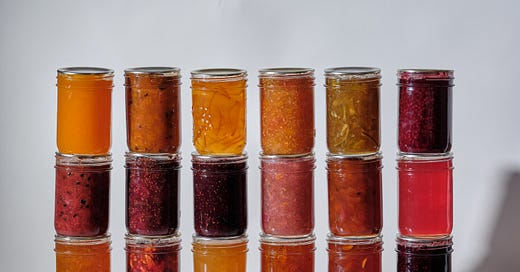Hello KP+ gang,
Today I’m handing the reigns over to Jam Goddess and Author of ‘Jam Bake’ Camilla Wynne for a Strawberry Jam recipe that will see you through the season.
Camilla is a pastry chef and preservation expert - she is one of Canada’s only master preservers and runs online (and in person) workshops. She is also the author of two brilliant preserving books. Her second book ‘Jam Bake’, which came out in 2021, is by far my favourite and most-referred to pastry book from the past year.
‘Jam Bake’ is both a practical guide to the nuts and bolts of jam-making, and a multi-coloured kaleidoscope of inspirational jam-infused recipes, so you can really put your preserves to work (think cheesecake scones and chocolate damson ice cream):
Camilla is here to kick off strawberry season with a classic strawberry jam recipe. Not only will this serve you throughout the summer - and thus the rest of the year - it’s an essential component for all of the trifle joy.
Also, I checked with Camilla and you can absolutely use the strawberry pulp leftover from from the trifle jelly making to bolster your recipe - just chuck it into your jam. She also mentioned you could use the pulp to make fruit leather, but perhaps I’ll ask her to dive into that in more detail for us one day.
I’ll be back mid week next week to share the GIFs and final recipe method for the trifle eleganza - so until then, here’s Camilla!
Strawberry Jam
words and recipe by Camilla Wynne
Strawberry jam is a classic, yet one of the more difficult jams to master. Still, it’s often the first thing novice preservers try their hand at. Strawberries have very low pectin and tend to foam formidably. That said, it’s easy enough to get a nice soft set with some practice.
Using a mixture of 75% perfectly ripe and 25% slightly underripe berries will help achieve a good set, as the berries lose pectin as they ripen. Don’t worry—the underripe ones disappear into the mix. And while I don’t usually recommend skimming jam, strawberries make so much foam that it’s worth doing here, simply for aesthetic reasons.
Makes four to five 250mL jars
1.2 kg (8 cups) rinsed, hulled strawberries PLUS any strawberry goo left over from jelly making!
600 g (3 cups) sugar
60 mL (1/4 cup) lemon juice
1/2 tsp citric acid*
*if you don't have citric acid it can be omitted, but it does give the fruit back its fresh fruit flavour that gets dampened by cooking.
Method
In a large bowl, combine strawberries, sugar and lemon juice. Ideally, leave the mixture to macerate overnight at room temperature, but if you’re in a rush wait a bare minimum of 15 minutes. Alternatively, they may macerate in the refrigerator for up to 1 week.
Before cooking the jam, prepare clean jars by placing them upside down on a rimmed baking sheet in a 120°C (250°F) oven for at least 20 minutes.
Once the sugar has drawn out some juice and softened up the strawberries, mash them by hand and squeeze them with your fists. Not only is this fun, it makes for a rough, uneven texture that I love. It also takes 5% of the time it would to chop them all up with a knife. If it freaks you out… wear latex gloves!
Transfer the mixture to a pot or preserving pan. Heat on medium-high and bring to a hard boil, stirring frequently. Use a large spoon to skim excess foam from the surface. When bubbles become larger and more rhythmic and start sputtering slightly violently, and the surface of the jam is glossy and jewel-like, test the set. The jam should slide off the spatula in sheets or clumps or try to cling to the spatula when you bring it to eye level. If you’re uncertain, put a teaspoon of jam on an ice cold plate and place in the freezer for two minutes. Remove and run your finger through the jam. If it has formed a skin and parts evenly, it’s ready; if not, continue cooking a few minutes longer.
When the setting point is reached, remove from the heat and add the citric acid, stirring well to combine. Immediately pour into the prepared jars to within a ¼- to 1/8-inch of the rim. Wipe the rims if necessary, seal, and invert for 1 to 2 minutes. Flip right side up and allow the jam to sit, undisturbed, for 24 hours.









Hello Nicole! I go really into depth about it in my book Jam Bake, but essentially if filling sterilized jars with jam while it's hotter than 90C/194F there's no need for a water bath, since the point of a water bath is to get the center of the jar to that 100C/212F (which the jam would have been above during cooking). This method is only ok for jams, jellies and marmalades which attain those temps during cooking. It's a common method outside of North American but usually only seen in artisanal production in N. America.
If you would rather water bath the jars, you absolutely can for 5 minutes in sterilized jars or 10 minutes in clean room temp jars. Or just put them straight in the fridge where they'll keep 6 months or so.
Hi there! The addition of citric acid is a nice touch. I’ll need to try it in my next batch of strawberry jam. As a long time preserver, though, I was surprised to see that the jam in this recipe was not processed in a boiling water bath or steam canner. As there was no mention of refrigeration for storage, I was a bit confused. Can you let me know Camilla’s intent? Thanks!